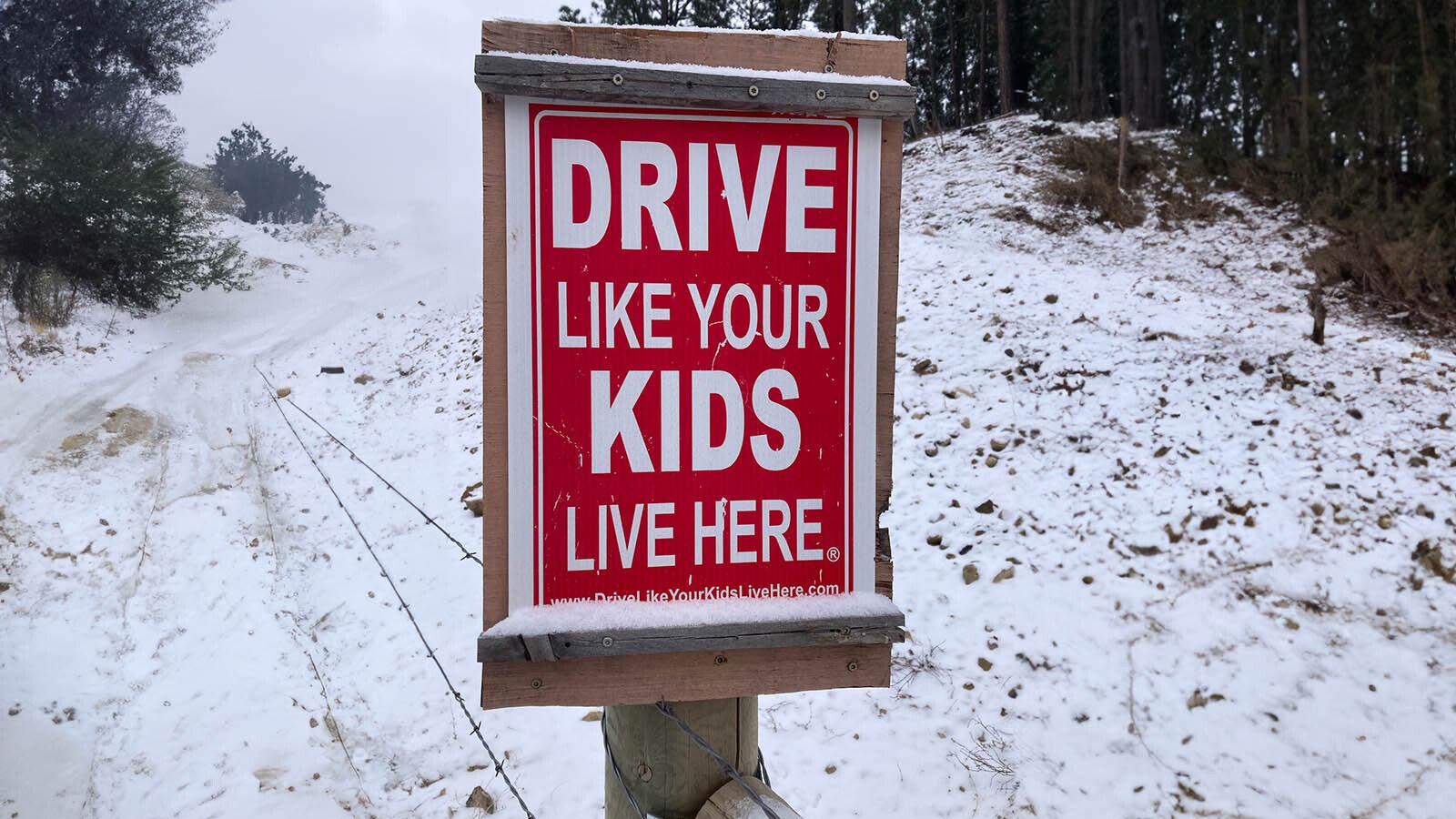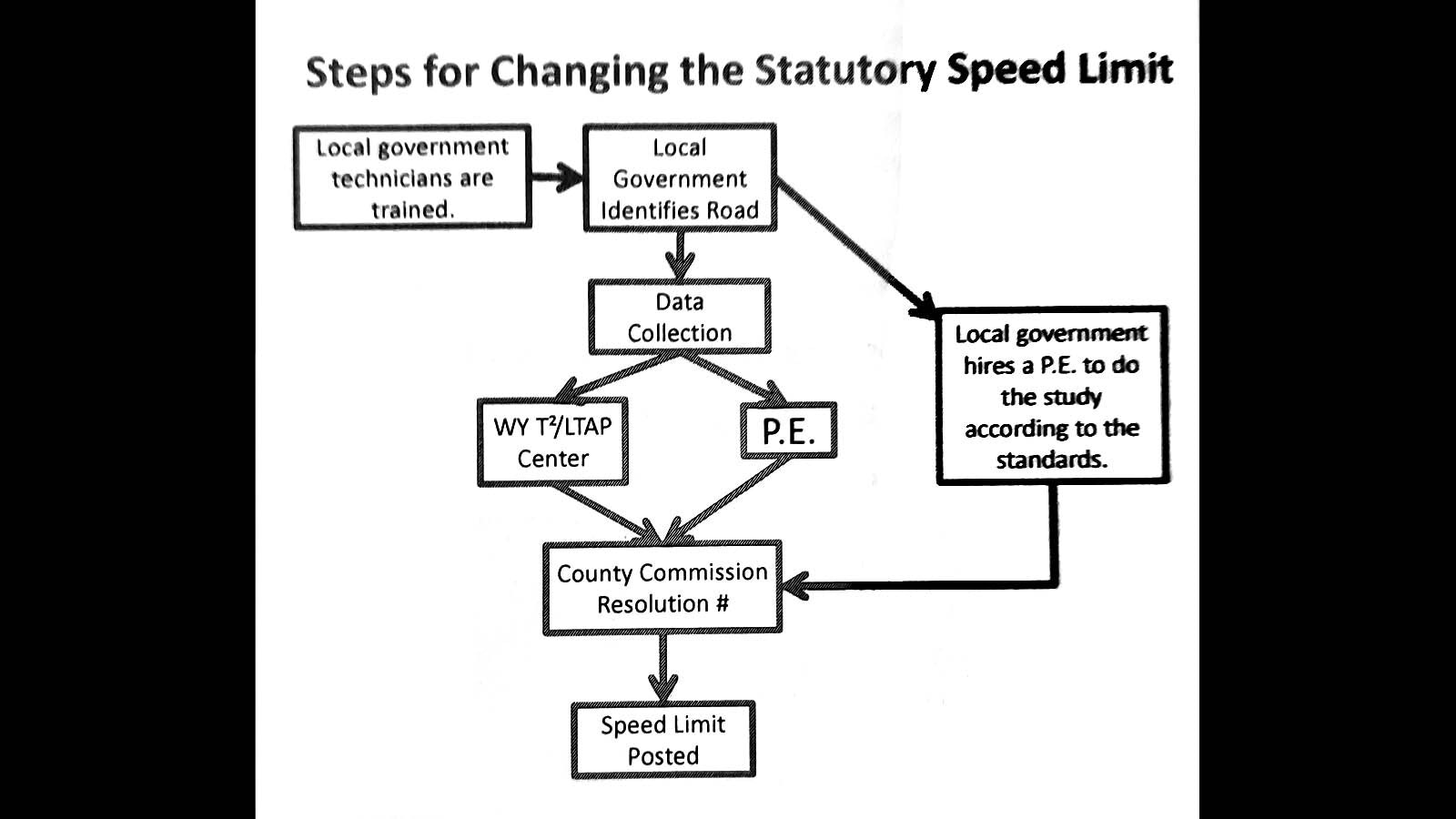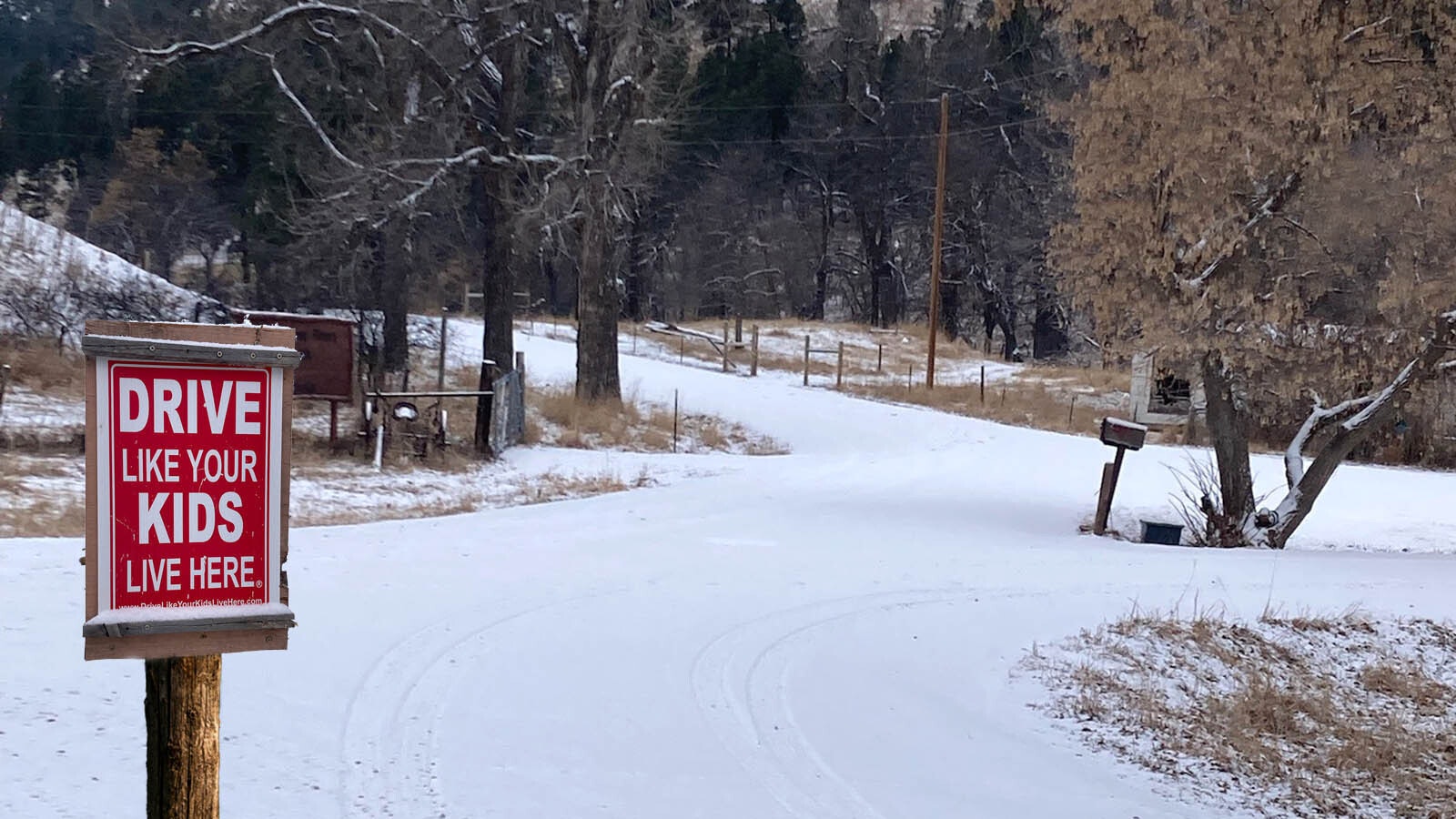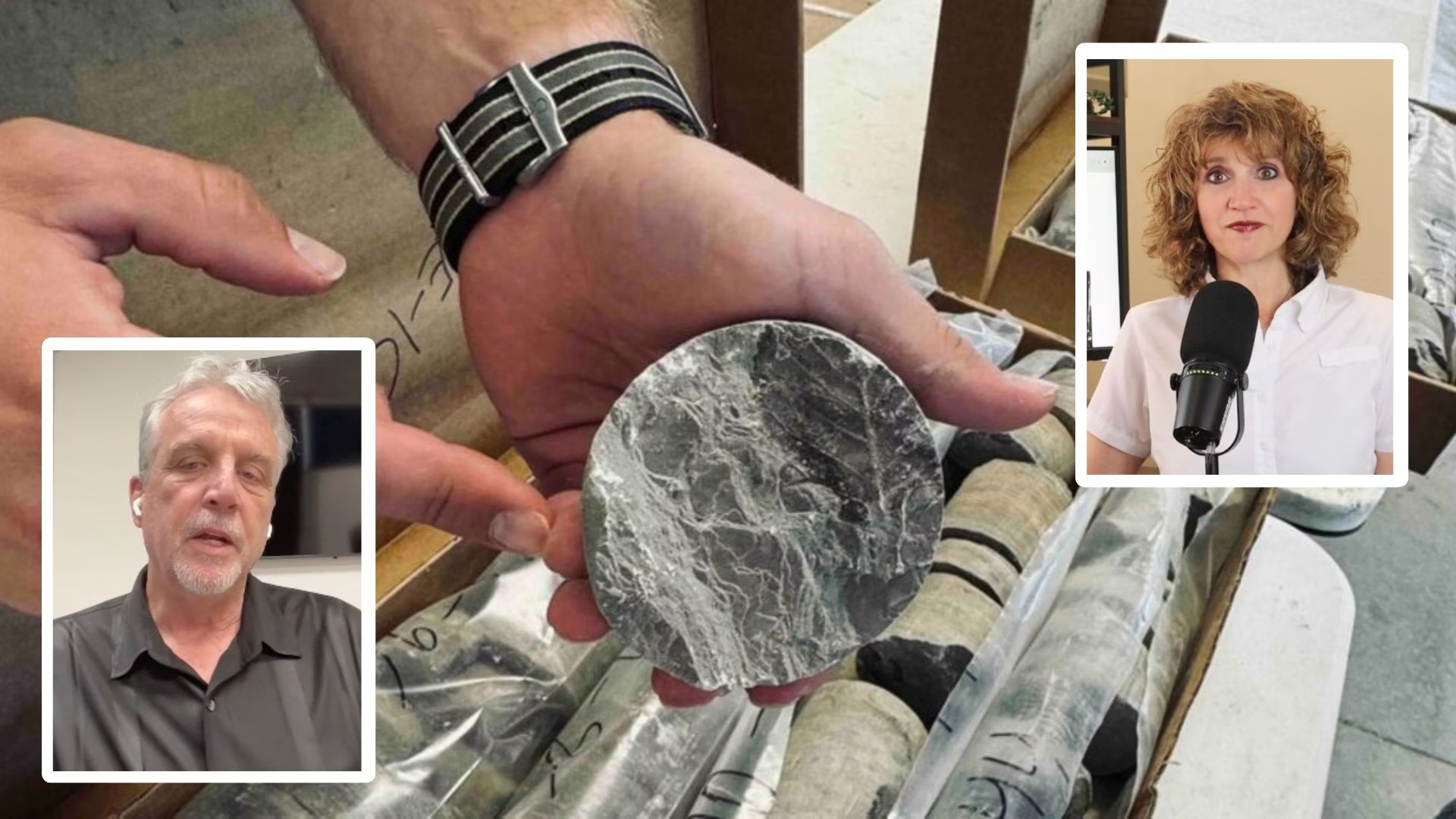Dave and Linda Wolfskill look forward to their early morning visits from their grandson. The third grader pops by on his way to school to drop off his puppy and say hello.
He lives across the way from his grandparents on Barlow Canyon Road, a roughly 12-mile stretch that bypasses directly through the Wolfskill’s fifth-generation ranch nestled between Devils Tower and Hulett, off Wyoming State Highway 24 in Crook County.
In years past, nobody thought twice about crossing the road, let alone a sleepy child in the early morning hours. Today, however, the influx of traffic and vehicles speeding up to 40-45 mph through the Wolfskill property has prompted Dave to raise alarms.
It’s gotten so bad that Linda now refuses to take the family dogs and pet goat out for a stroll along the road after a near-miss a couple weeks ago.
“Two trucks blew by her,” Dave said. “This is our property, and it’s not even safe to walk on the road!”
As a local resident, his only recourse is to put up his own sign, which urges drivers to “Drive like your kids live here.”
“Some people must really hate their kids,” Wolfskill said wryly, noting the sign has done nothing to deter speeders.
Wolfskill said the problem has gotten increasingly worse over the past three years, which likely coincides with a population boom in Crook County, which is the second-fastest growing county in the state.
Between July 2022 and July 2023, the population in the county increased by 2.3%, according to a report from the Wyoming Economic Analysis Division.
Wenlin Liu, chief economist for the state, attributed the growth to increased births as well as net migration as people both outside and within the state continuing to relocate to less sparsely populated pockets in Wyoming post-pandemic.
State Control
Diane and Utah Marshall share the Wolfskills’ concern about the safety of children on some of these rural roads, often unpaved, winding and rutted.
In fact, Diane recently had a near-miss with her own 7-year-old grandson, who was attempting to get the feel of the handbrakes on his new bike when he drifted out of his driveway onto Bear Lodge Road, 6 miles from Sundance.
She had just turned onto the road that she also lives on and was going slowly enough to easily stop in time. A few seconds later, however, a pickup came flying around the bend. Had she not got there first, the vehicle likely would have hit him.
That heart-stopping moment prompted her to reach out to her three county commissioners — Chairman Fred Dervish, Vice-Chairman Kelly Davis and Bob Latham — with her concerns, echoing complaints already shared by Wolfskill.
Marshall said the commissioners were sympathetic, though they explained there was little they could do since the state Legislature set new speed standards and guidelines for determining speeds in 2011, removing authority from the counties.
The new standards adopted by the Legislature were developed by the Wyoming Department of Transportation as well as the Wyoming Technology Transfer Center (WYT2/LTAP), which set speeds on county roads at 55 mph for unpaved and 65 for paved.
Those standards also required counties to collect data and conduct a road study signed by an engineer at which point results are presented to county commissions to vote on.
WYT2/LTAP offers these engineering studies for free. The center is sponsored by the Federal Highway Administration in cooperation with the university, WDOT and cities and counties throughout the state.
Bart Evans, a safety analyst with the center, told Cowboy State Daily that the center will send staff to set up traffic counters, do radar checks for speed and assess road conditions and other engineering and traffic concerns.
Studies have to be signed off by director and engineer, Khaled Ksaibati, as well as either a county or city engineer, Evans said.

Lack Of Signage
The problem that the Wolfskills, Marshalls and other residents have with the newly adopted state road rules is that they feel a speed limit of 55 mph on gravel roads is too fast in general.
The law also doesn’t take into account residential properties nor require drivers to slow down while passing through ranchers’ properties or around blind curves and steep hills that aren’t always marked with cautionary road signs as they are on state highways.
And where it might be natural to be neighborly to slow down for safety, many residents say those good manners seem to have gone by the wayside.
Crook County resident Laurie Tucker, who lives on Strawberry Hill Road 12 miles north of Hulett, said she’s seen an influx in all traffic — including semitrucks and trailers — zooming along her narrow, gravel country road.
Where she drives 30-35 mph and hugs the right side of the road, she said other drivers buzz by at 50-60 mph along the middle of the road. On more than one occasion, Tucker said she’s been driven off the road by erratic drivers.
The lack of signage marking hills and blind curves, such as the one she lives on, is also a problem, she said, and feels it’s only a matter of time before someone dies or is seriously hurt.
Commission Chairman Fred Dervish said that the county Road and Bridge Department has not received any recent requests or complaints related to signage, but over the years has put up warning signs on roads marking curves and other safety hazards.
“We have thousands of ‘Open Range’ signs for livestock protection, although I am more concerned about the safety of the driver than the livestock,” he said. “If there were to be a park, playground or school near the county road, we would definitely consider appropriate signage, but I am unaware of any specific condition.”
Dervish also said the commission purposefully avoids putting up speed signs on statutory default 55 mph roads to deter drivers from going that fast.
He also said that the commission does have the authority to issue warning signs upon request.
“We mark what we feel to be prudent and necessary and consider all requests,” he said.
White-Knuckle Drives
Tucker now drives defensively, and like many rural dwellers has learned to watch the dust plumes on the road for oncoming traffic.
Stephanie Rathbun also has been run off the road by vehicles driving in the middle.
She, too, has noted a sizeable increase in traffic on Barlow Canyon Road, particularly construction equipment as more newcomers move in and build housing.
Recently, the county has widened and improved conditions on the road, which both Wolfskill and Rathbun appreciate, but said it’s a Catch-22 in that more vehicles are now on the road.
Following the pandemic, Rathbun said she has noticed more people moving into the county from the East and West Coasts who may not understand that they are driving right through people’s properties on some of the stretches of county roads.
“Some people don’t understand open range and that you’re driving right through people’s homes,” she said.
She’s also seen an influx of more nomad campers staying on Bureau of Land Management land off local roads.
That type of public land use has “really picked up since COVID,” she said.
Like the others, she’d like to see the speed limits reduced on some sections of the roads to 30-35 mph.

Easier Said Than Done
Crook County Commissioner Kelly Dennis agrees with his constituents and said people speeding on rural county roads has been a longstanding problem dating back to his first year in office. He’s been on the commission for 16 years and said this issue came up on Day One.
He’s a rancher with two operations in the county and spends a lot of time driving these same roads. Along with safety, dust has also been a huge issue as traffic increases.
He also sympathizes with the Wolfskills and said he personally slows down to 10 mph while passing through their property. He also said that theirs is one of several properties throughout the county whose homesteads are bisected by county roads.
The trouble in his estimation is that there’s little the county can do about it now that the roads are under state control.
“The state has usurped so much of the authority that should belong to the county, and this is one of them,” he said. “A commission should be able to set their own speed limits on their roads.”
In the past, the county had reduced speed limits on some roads that were grandfathered in under the new rule changes.
Under the new policies, the county has yet to do a speed change following three formal speed studies in 2012 and 2013 on Bertha, Kara Mountain and Sand Creek roads.
“None of these studies yielded any results to change the speed limits as the data did not support the need,” he said, noting the study was reviewed by third-party party engineers and thus voted down by the commission.
Successful In Other Counties
Other counties have had better luck reducing speeds along county roads. In 2022, Carbon County both lowered and raised speed limits on five county roads.
The speeds were lowered on some roads following the request of some residents, who expressed concerns about motorists driving too fast, according to Kandis Fritz, Carbon County Road and Bridge superintendent.
She’s been with the department in different capacities for 21 years, and after becoming director, learned more about services offered by the Wyoming Technology and Transfer Center, including conducting free speed index surveys.
“It was no cost to the county,” she said. “They came out and did a traffic study and helped us set official speed limits on those roads.”
The county is currently working with the state on more county road studies and said they are more than happy to come out and help.
It’s not clear how many counties have altered speed limits on their rural roads as that information is not tracked by WYDOT, according to spokesperson Doug McGee.
Crook County Road and Bridge Superintendent Morgan Ellsbury did not return Cowboy State Daily’s request for comment regarding the county’s plans for future road studies.

Hope For The Wolfskills?
A few weeks ago, Wolfskill said that the county placed a traffic counter on the portion of road crossing his land.
Whether this leads to an actual road study is yet to be determined, Dervish said.
“There are several important factors to consider when changing a speed limit, but first need to determine if there is even a problem,” he said. “The process requires an investment of time, effort and money. A speed limit will not be established quickly or carelessly, (and) public input, law enforcement input and engineering input will be gathered.”
Wolfskill is hopeful, but said he’s not holding his breath that anything will actually be done to prevent fast drivers speeding through his property.
At least once a day, he counts a vehicle buzzing through at more than 40 mph with a few notable exceptions, such as UPS drivers as well as the fleet of Bridger Pipeline trucks going back and forth to the pipelines and pump station.
“One of their bosses told them that if they even hit a turkey, they’d be fired,” he said.
In the meantime, Wolfskill stays on high alert watching for his grandson and hopes for the
Jen Kocher can be reached at jen@cowboystatedaily.com.





